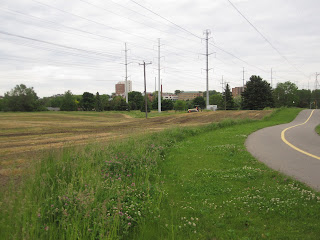These days, I spend quite a bit of time exploring the Gatineau Hydro Corridor. This strip of greenspace runs through Scarborough from the Don Valley, all the way northeast through to the Rouge Valley and beyond. Massive hydro towers carry power for the city through the corridor. This area must be kept free of any obstacle. In some ways, this provides some interesting opportunities for the land beneath the power lines. A well-maintained, paved trail system meanders through the corridor. Along this trail, you can find some of the largest community gardens I have ever seen, cricket pitches, and native plant restoration projects.

I first visited this area in the summer of 2012, while I was working for Ontario NativeScape and the Rural Lambton Stewardship Network (RLSN) out of Chatham, Ontario. RLSN was established in the early 90s as one of the pilot stewardship councils with the Ministry of Natural Resources. Over the years, RLSN has developed the capacity to complete large scale tallgrass prairie restoration projects throughout the province. They have created about 260 acres of native seed production area on farmland in Lambton County. It is amazing to see native plants, ones that are sometimes rarely found in nature these days, growing in agriculture fields. You can walk through the fields any time of year and find something incredible; thousands of prairie smoke in flower in the spring or millions of bright yellow blooms in late July.
In summer 2012, I was here to complete a site visit with the restoration project team. The site has since been prepped and planted.
The morning the first fields were planted, I rode my bike down the trail to visit my old coworkers. I love seeing seed go into the ground. Means most of the hard work, planning the restoration project, getting the funding and permits together, is all done and now it's just up to the seeds to out compete the weeds.
This site was prepped with an annual rye. The hard little flower heads stick to your fingers like Velcro.
City of Toronto was also in on this project, planting a wide variety of native shrubs in several plots. These shrubs will provide all sorts of berries for food and shelter through the seasons for local birds, insects, and other wildlife who call the hydro corridor home.

I ride my bike along the trail several times a week. Have to take my camera back up and show an update of this project. Weeds are doing well this first season, as is to be expected, but the crew at TRCA is doing a great job keeping them at bay and giving the native plants a chance to establish. The native plants have deep, fibrous root systems that take about three growing seasons to develop. The competitor weeds have small roots systems that allow them to quickly pop up and fill the space and take advantage of the available resources. Once the native plants are established, the weeds won't stand a chance. The extensive root systems will reach deep for water, hold the soil in place and prevent erosion, and create healthy, well-structured soil for the next generation of native plants to establish.
I can't wait to see this place all grown up!
















